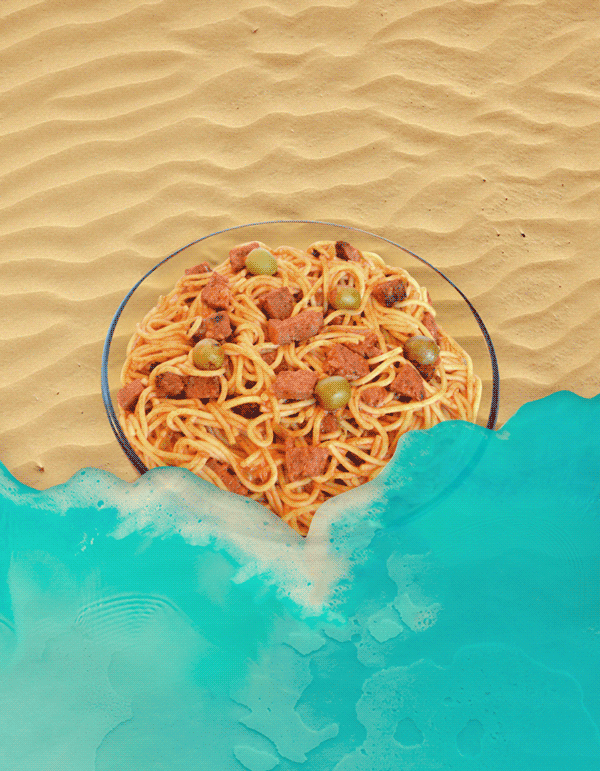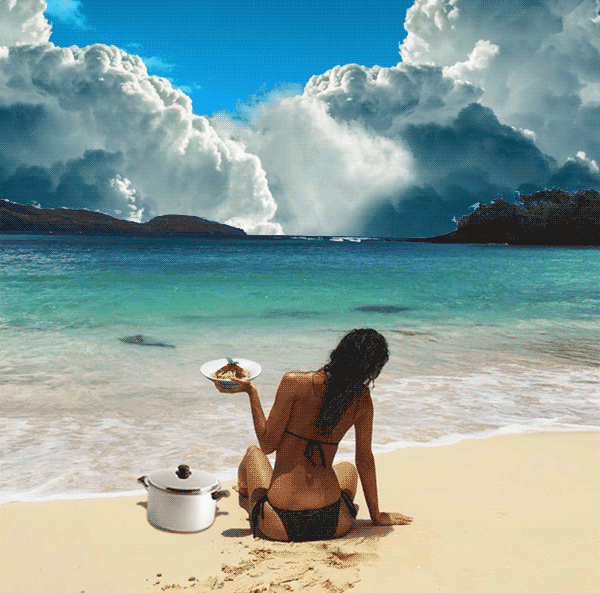When you think of beach foods, your mind may conjure images of charcuterie, fruits, and chips – picaderas that won’t leave you feeling stuffed and interfere with your ability to go for a swim. But head to the beach with enough Dominicans, and you may learn that for some, seaside trips require spaghetti – a carb-heavy food that can become unwieldy when you’re not guaranteed a seat at a table. It’s a tradition of sorts that outsiders may not understand, but one that is deeply tied to Dominican culture.
Most people associate the DR with the classic mangú con los tres golpes (salami, fried cheese, and eggs). But to know the country is to know that spaghetti forms an important part of its culinary identity – though it’s hardly recognized as such. Dominicans take their spaghetti very seriously. For starters, jarred sauce isn’t part of the equation. Dominicans almost always make the sauce from scratch. The entire meal also comes together with as few shortcuts as possible – something Dominicans take great pride in. One time, a friend boasted that she didn’t even need cubitos de sazón to give the dish depth of flavor.
Traditionally, homemade tomato sauce, garlic, and onions give Dominican spaghetti its flavor. But pan sobao or pan de agua is a necessary accompaniment for the requisite spaghetti sandwiches. Casabe – an important part of the Taíno diet and one of the indigenous group’s most prevalent contributions to the DR’s culinary heritage – is a cracker-like flatbread made from ground yuca. This is another popular pairing for spaghetti. Though pasta, sauce, and bread is delicious enough on its own, some Dominicans get creative and add salami, salchicha, pollo guisado, or other additives, like corn. Despite how much love they put into this meal, it’s still easy to whip up, making the dish an apt choice for empaguetadas – something that occurs when big groups hang out and make lots of spaghetti.
For many, empaguetadas come with close associations to the beach. But as most of the country’s seaside locations become privatized by the tourism industry – a 2005 Diario Libre article reported that hotels owned up to 70 percent of the DR’s beaches – Dominicans who cannot pay to access these spaces are excluded. This has, in part, contributed to the decline of Dominicans eating spaghetti at beaches. (There’s also more eateries at beaches now, which makes it less necessary for some to take their own foods.) But empaguetadas are still going strong. Whether it’s eaten at parties or it serves as a spur-of-the-moment solution for when many hungry Dominicans get together and require immediate sustenance, empaguetadas are a way of life. I remember having empaguetadas regularly when I hung out with my friends as a 15 year old. They provided a quick and cheap way to feed many mouths.

It’s likely that the practice of eating spaghetti at beaches also started as a way to affordably feed a large group. But it’s also more than that. Poking around some more to get to the bottom of this phenomenon, it’s become increasingly clear that this custom also derives from community. According to older generations of Dominicans, when large groups rented buses from the campos to the beaches, locals – who paid a small fee – received spaghetti con casabe in exchange.
Though some of the circumstances make this experience uniquely Dominican, they’re not the only ones who enjoy a little spaghetti at the beach. Neapolitans consume frittata di maccheroni – often made with leftover spaghetti – while soaking up the sun. But because Neapolitans transform the pasta into an omelette, it becomes a travel-friendly finger food.
As this Dominican tradition has passed down from generation to generation, the origins have naturally become nebulous. But what is apparent is that making spaghetti for beach trips is an example of our ingenuity and typical of Dominican wit. Though this often makes us subject to ridicule, we should celebrate what is actually a show of our resilience. Seaside spaghetti is representative of our ability to make something out of nothing or very little. My grandma, for example, felt a sense of fulfillment when she could stretch meals, because in a country that suffers from economic inequality, this is crucial. It’s why dishes like spaghetti or arroz, habichuela, y carne – aka la bandera Dominicana – have defined Dominican cuisine.
One day, eating spaghetti at the beach may become obsolete, which is why highlighting this part of our culture is necessary. To learn more about the tradition, I spoke to several young Dominicans – all of whom currently live in the US, though many have spent considerable time in the DR – to see how it became a treasured part of their childhoods. Their stories are a testament to the Dominican spirit.
Zaurria-Makala Frias
“The first time I ate spaghetti on the beach when I was younger, I was very confused on how and why would my family bring spaghetti out of all things to eat,” Zaurria-Makala Frias says. Rice and beans, and frituras seemed like more logical choices for the New Jersey-based student. But Zaurria – who has eaten spaghetti at the beach several times – has grown to appreciate the tradition.
The half Dominican Zaurria doesn’t get to partake in the tradition as often as she likes, because she spends most of her time with her Puerto Rican mother. But on her last outing to the beach, she longed for more of this custom after spending the day with her friend, whose family does eat spaghetti by the sea. “Going to the beach with my best friend and her family was so nostalgic, and it made me very happy to see her bring the big pot out to feed the family,” Frias says, adding that the meal was delectable.
“I only [initially] found it weird because I was accustomed to the American beach day, with just snacks and drinks. But once I was brought around my father’s side more, it wasn’t so weird to me. I still don’t fully get it to be honest, but I do know that I love the tradition regardless.”
Whenever she goes to the beach with her Dominican family, she consumes spaghetti, bread with butter, and sometimes yaniqueques, too. “I love it because I’m never hungry at the beach when we bring food,” she concludes.
Adriano Contreras
Adriano Contreras learned from his mother that spaghetti was a matter of convenience. “If you roll up at the beach with 20 family members, you don’t want to make 20-30 sandwiches,” the NYC-based photographer says. “Throw three or four boxes of spaghetti into some boiling water, and later drown it in tomato sauce and olive oil.”
He distinctly remembers going to the river in the DR once. As soon as his family found a spot, two of his relatives held a stockpot. “Before any of us got into the water, they passed around styrofoam plates and unveiled this huge pile of greasy orange spaghetti,” he says. He felt disappointed. At the time he didn’t enjoy eating pasta, and then he also felt too full to swim.
He hasn’t always appreciated the tradition, but he came to understand it after traveling across Latin America on limited funds. Of course, if he were to repeat the tradition today, his spaghetti would look a little different. He can no longer stomach the canned parmesan cheese that made its way onto his plate as a kid. “Now, I’m a total pasta snob,” he confesses.

Deborah Cosma
“It’s a little rare eating spaghetti at the beach when you can have other things less complicated to take with you, like a sandwich or something like that,” says Deborah Cosma, a student who recently moved to Tampa, Florida from Santo Domingo. She struggled to keep sand off her plate, which made for a somewhat unpleasant eating experience. “I remember eating my spaghetti with sand of the beach,” she adds. “I don’t remember exactly how it got there, but I ran my fingers through it.”
However, she wanted the full Dominican beach experience, so she didn’t complain. Now she considers the sandy spaghetti a source of pride. “A Dominican person who hasn’t eaten spaghetti with a little bit of sand at the beach is not Dominican,” she jokes.
Pamela Reynoso
Growing up in the DR, Pamela Reynoso can still remember the smells emanating from the kitchen on beach days. “Nothing says ‘levantese, que hoy vamo pa la playa’ more than the smell of spaghetti con salami o chuleta first thing in the morning,” says Reynoso, who lives in Brooklyn and works as Remezcla’s social media manager.
Reynoso doesn’t know how the tradition began in her family, though she theorizes it’s because of convenience. Even with sand everywhere, taking a pot (and she’s adamant that it needs to be a pot and not a tupperware or container) full of pasta to the beach still makes the most sense. “Lord knows I had to wait forever to get back in the water after eating epageti,” she adds. “I really think it’s just an affordable way to keep your family and friends fed, porque lo’ epageti rinde mas quel diablo, so you can save the rest of the budget for the romo and pescado frito con yaniqueque.”
To Pam, this long-established habit didn’t seem unordinary until she discussed it with her coworkers. “I didn’t realize this practice was odd until I mention it to the Remezcla Estaff, and all the non-Dominicans were like, ‘wuuuuut?’” she says. “That took some explaining.”
Nowadays, she doesn’t get to eat the meals as much because she’s not living with her mother, who’s in the DR, and for her the tradition didn’t carry to the states. Regardless, it’s something she looks back on fondly.
Felix Cepeda
For Felix Cepeda’s family, the tradition migrated to the US, likely because as many Dominicans know, it’s cheap and easy to make. Sometimes his family would eat the pasta with bread, and they’d even make spaghetti sandwiches. “A few years ago, I was in the Dominican Republic, at the beach, and some friends made it,” the activist, who splits his time between New York and Santo Domingo, says. “Even though, I am not a huge fan, when you get out of the water, and you have been in the ocean for a while, you come out hungry. And it does taste yummy.”
Spaghetti was an important part of his childhood. His family ate it at the beach, but also anytime there was a huge gathering of people. “In the poor neighborhoods in Santo Domingo – not just at the beach but even get-together or parties – spaghetti is almost always served,” he says.
But to him, the food isn’t just about affordability; it’s a testament to the character of Dominicans. “It’s also says a lot about us, because we are a sharing community, we always want to offer something to others,” he says. “Some folks cook it so well and with so much love that it tastes like a gourmet meal.”







